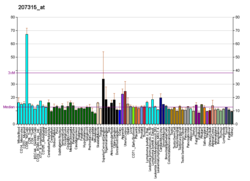| CD226 |
|---|
 |
|
| Structures disponibles |
|---|
| PDB | Recherche d'orthologue: PDBe RCSB |
|---|
| Identifiants PDB |
|---|
6ISA, 6ISC, 6ISB, 6O3O |
|
|
| Identifiants |
|---|
| Aliases | CD226 |
|---|
| IDs externes | OMIM: 605397 MGI: 3039602 HomoloGene: 4787 GeneCards: CD226 |
|---|
| Position du gène (Homme) |
|---|
 | | Chr. | Chromosome 18 humain[1] |
|---|
| | Locus | 18q22.2 | Début | 69,831,158 bp[1] |
|---|
| Fin | 69,961,803 bp[1] |
|---|
|
| Position du gène (Souris) |
|---|
 | | Chr. | Chromosome 18 (souris)[2] |
|---|
| | Locus | 18|18 E4 | Début | 89,195,091 bp[2] |
|---|
| Fin | 89,290,353 bp[2] |
|---|
|
| Expression génétique |
|---|
| Bgee | | Humain | Souris (orthologue) |
|---|
| Fortement exprimé dans | - monocyte
- sang
- ganglion lymphatique
- rate
- appendice iléo-cæcal
- nerf sural
- cellule de la moelle osseuse
- vésicule biliaire
- gyrus frontal moyen
- tendon calcanéen
|
| | Fortement exprimé dans | - sang
- rate
- thymus
- moelle osseuse
- secondary oocyte
- subcutaneous adipose tissue
- œsophage
- Cellule de Paneth
- corps du fémur
- lobe pulmonaire droit
|
| | Plus de données d'expression de référence |
|
|---|
| BioGPS |  | | Plus de données d'expression de référence |
|
|---|
|
| Gene Ontology |
|---|
| Fonction moléculaire | - protein homodimerization activity
- liaison protéique
- protein kinase binding
- integrin binding
- cell adhesion molecule binding
| | Composant cellulaire | - integral component of plasma membrane
- radeau lipidique
- integral component of membrane
- membrane
- surface cellulaire
- external side of plasma membrane
- membrane plasmique
| | Processus biologique | - positive regulation of natural killer cell mediated cytotoxicity directed against tumor cell target
- adhésion cellulaire
- regulation of immune response
- heterophilic cell-cell adhesion via plasma membrane cell adhesion molecules
- homophilic cell adhesion via plasma membrane adhesion molecules
- positive regulation of Fc receptor mediated stimulatory signaling pathway
- cell recognition
- cytokine production
- positive regulation of immunoglobulin mediated immune response
- transduction de signal
- positive regulation of natural killer cell mediated cytotoxicity
- positive regulation of mast cell activation
- positive regulation of interferon-gamma production
- positive regulation of natural killer cell cytokine production
- positive regulation of T cell receptor signaling pathway
| | Sources:Amigo / QuickGO |
|
| Orthologues |
|---|
| Espèces | Homme | Souris |
|---|
| Entrez | | |
|---|
| Ensembl | | |
|---|
| UniProt | | |
|---|
| RefSeq (mRNA) | |
|---|
NM_001303618
NM_001303619
NM_006566 |
| |
|---|
NM_001039148
NM_001039149
NM_178687 |
|
|---|
| RefSeq (protéine) | |
|---|
NP_001290547
NP_001290548
NP_006557 |
| |
|---|
| Localisation (UCSC) | Chr 18: 69.83 – 69.96 Mb | Chr 18: 89.2 – 89.29 Mb |
|---|
| Publication PubMed | [3] | [4] |
|---|
|
| Wikidata |
| Voir/Editer Humain | Voir/Editer Souris |
|
Le CD226 (ou DNAM-1) est une protéine de type cluster de différenciation dont le gène, CD226, est situé sur le chromosome 18 humain. Il agit comme un récepteur à la surface de certains lymphocytes
Rôles
Ses ligands sont le CD155[5] et le CD112[6]. Il permet la stimulation des lymphocytes NK, avec production de cytokines dans certains cancers[5]. Son action sur le CD155 est cependant contrecarrée par le CD96[7].
Le CD226 facilite également la différenciation et la prolifération des lymphocytes par son interaction avec le LFA-1[8].
En médecine
Plusieurs médicaments utilisés dans le traitement du myélome multiple, tel que la doxorubicine, le melphalan, ou le bortezomib, stimulent ce récepteur, et par ce biais, les lymphocytes NK[9].
Notes et références
- ↑ a b et c GRCh38: Ensembl release 89: ENSG00000150637 - Ensembl, May 2017
- ↑ a b et c GRCm38: Ensembl release 89: ENSMUSG00000034028 - Ensembl, May 2017
- ↑ « Publications PubMed pour l'Homme », sur National Center for Biotechnology Information, U.S. National Library of Medicine
- ↑ « Publications PubMed pour la Souris », sur National Center for Biotechnology Information, U.S. National Library of Medicine
- ↑ a et b Chan CJ, Andrews DM, McLaughlin NM et al. DNAM-1/CD155 interactions promote cytokine and NK cell-mediated suppression of poorly immunogenic melanoma metastases, J Immunol, 2010;184:902–911
- ↑ de Andrade LF, Smyth MJ, Martinet L, DNAM-1 control of natural killer cells functions through nectin and nectin-like proteins, Immunol Cell Biol, 2014;92:237–244
- ↑ Chan CJ, Martinet L, Gilfillan S et al. The receptors CD96 and CD226 oppose each other in the regulation of natural killer cell functions, Nat Immunol, 2014;15:431–438
- ↑ Shibuya K, Shirakawa J, Kameyama T et al. CD226 (DNAM-1) is involved in lymphocyte function-associated antigen 1 costimulatory signal for naive T cell differentiation and proliferation, J Exp Med, 2003;198:1829–1839
- ↑ Soriani A, Zingoni A, Cerboni C et al. ATM-ATR-dependent up-regulation of DNAM-1 and NKG2D ligands on multiple myeloma cells by therapeutic agents results in enhanced NK-cell susceptibility and is associated with a senescent phenotype, Blood, 2009;113:3503–3511
 Portail de la biologie cellulaire et moléculaire
Portail de la biologie cellulaire et moléculaire  Portail de la médecine
Portail de la médecine

 Portail de la biologie cellulaire et moléculaire
Portail de la biologie cellulaire et moléculaire  Portail de la médecine
Portail de la médecine 



















